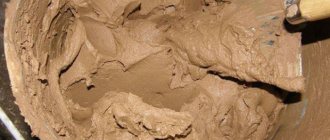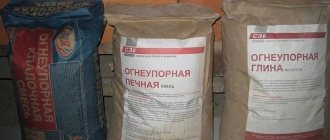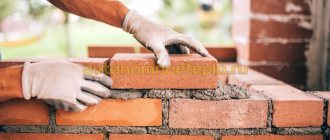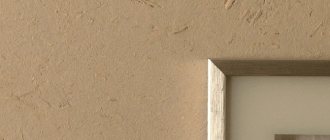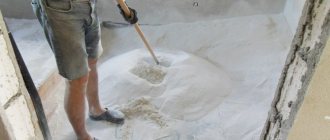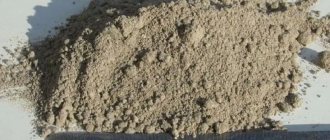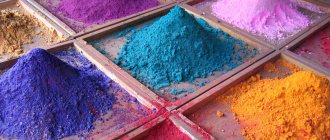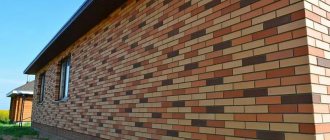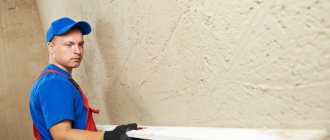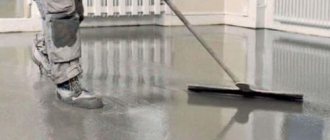Furnace technologies are very conservative, since they are refined to the detail.
Like many centuries ago, modern craftsmen require clay for laying stoves - the main component of the mortar, similar in composition to the brick itself.
An average of 3 buckets of this mortar is consumed for every 100 bricks. And it must be a solution made according to all the rules. Let's reveal the secrets of experienced stove makers.
Furnace design and masonry mortar
Brick sauna stoves are large structures, their parts function in different conditions. The humidity level and temperature conditions at the base of the stove, next to the firebox and in the chimney duct are different. Temperature delta can reach from 0 to 1000 degrees or more. Smoke passes through the firebox and chimney. In addition, the pipe is exposed to rain, wind and cold. A universal mortar that would fit all these parameters and withstand them with honor has not yet been invented.
Cement or lime, either together or separately, cannot withstand such a temperature range.
On a note. Clay spreads in water, lime allows gases to pass through. Therefore, where the steam room, washing room and rest room use at least three types of masonry mixtures. They will all be different in their performance characteristics.
In addition, it should be borne in mind that fire-resistant solutions are expensive. It is advisable to use them where the maximum temperature develops. But for the foundation and main structural parts of the furnace, you can prepare cheaper mixtures. Clay is considered a relatively inexpensive building material. If you wish, you can obtain it yourself, and then the solution will be practically free. All that remains is to determine its quality and suitability for masonry and prepare it in a special way.
Clay sand mortar for furnaces is also sold and manufactured in factories. There is already a calculated ratio of components. The big disadvantage is their high price; the oven will turn out golden, because you need quite a lot of solution. For comparison: for 100 bricks you need about 2-3 buckets of the mixture. The exact quantity depends on the thickness of the seams and the density of the rows. Each master has his own style of masonry and, accordingly, the consumption of mortar.
If you recalculate factory mixtures to the actual scale of construction, then thrifty owners will not be pleased with the price. Therefore, you can take a closer look at budget masonry mortars that you can make yourself. It is also possible to prepare clay for ovens with your own hands; the composition of the solution will not be affected.
Main components
Used for stove foundations that are not exposed to heat. Cement and sand are taken in a proportion depending on the brand of binder: M400 – 1:4; M500 – 1:5. The dry ingredients are sifted and mixed with water. Viscosity is checked by the degree of adhesion to a wooden oar or shovel handle. It hardens quickly, so the batch must be prepared immediately before work.
The composition of complex solutions depends on the place of their application. To protect the foundation and the street part of the chimney from moisture, you can make a cement-lime mixture; for the main body of the furnace, a cement-clay mixture. They will increase the strength and water resistance of the masonry.
Preparation of a multicomponent mortar is reduced to mixing one part of cement, three portions of lime paste and from 5 to 15 sand. Kneading is done with a shovel or mixer. First, prepare a regular lime mortar, then add cement and add water. Another way is to mix the dry ingredients and add them to the diluted dough. It must be used within 45 minutes, otherwise it will lose its plasticity.
https://www.youtube.com/watch?v=78fqp8T0NoM
It is not difficult to make a high-quality solution for stove masonry yourself if:
- add clay of normal fat content into the composition;
- use soft or medium hard water;
- sift and clean sand from organic matter;
- soak the clay for several days;
- perform the kneading in the ratio determined experimentally;
- fireclay clay for a heat-resistant mixture is not marked with the letter “y” (recycling material from defective bricks);
- add the fatty variety to the lean clay;
- purchase sand of different fractions up to 1 mm.
Tags: sauna, clay, oven
« Previous entry
What are masonry mortars?
The composition of the mixtures is not complicated: one or two components and water. Binding elements - clay, cement, lime. The filler is sand, which can be silicate or fireclay. It is important to take water that does not contain impurities or any technical additives. Water from a tap, well or open reservoir is suitable. But the ideal liquid for the solution is considered to be rain or melt water.
Porosity, gas conductivity, and thermal conductivity qualities of solutions vary. They are united by ease of application, good ductility and high strength after the solution hardens. Each type of solution must meet its declared properties.
Furnace masters classify solutions into the following categories:
- Fatty, with good plasticity, but susceptible to cracking after hardening.
- Normal - having average ductility and strength, with their help they create reliable masonry. This kind of clay should be sought for construction work.
- Skinny - fragile and low-plasticity, not durable, crumble after drying. Such clay is not suitable for the stove; it will immediately damage it the first time it is lit. It can only be used when brought to the desired condition in combination with other plastic components.
When the mixture contains one binder component (cement, clay), the solution is classified as simple. The ratio of components is designated as follows: 1:1, 1:2, 1:3. These designations help you understand what proportions are used in solutions. The first number indicates the binder component, the second the filler. When the solution is complex, consisting of two binder components (cement-lime mixture), the designation is as follows: 1: 2: 8. The first number is the most effective binder. Stove makers use mixtures that are normal in plasticity and strength. Fatty solutions are brought to the desired condition by adding sand; thin solutions are mixed with lime or clay.
If we exclude the reinforced concrete mortar used in the foundation, the following types of mortars are used when constructing the furnace:
- Calcareous . Used for brick plinths and chimney ducts. That is, it can be used in the construction of parts where there will be no heating of more than 450-500 degrees above zero. The seams with this solution will be strong, but fire resistance will suffer. It cannot be used to construct a chimney, since this part of the structure is exposed to aggressive atmospheric influences. Lime mortar cannot be called wear-resistant.
- Cement-lime . They are used in the construction of foundations. It is not heat resistant and is not suitable for chimneys. Withstands temperatures no higher than 250 degrees above zero.
- Cement-chamotte . They are made of cement and heat-resistant fireclay sand and water. Used to build a firebox. Such a composition will easily withstand temperature loads of 1300 degrees and above and will not collapse. Such a seam will not let smoke through, but condensation can escape through it. Heat resistance, fire resistance, and ease of use are features of cement-fireclay mortars. But it comes out at a rather expensive price. Therefore, when building stoves for baths, they often make do with an analogue, where cement is replaced with clay.
- Clay-fireclay . Such solutions are also used when laying the combustion chamber, as they have fire-resistant properties. It turns out much cheaper than the previous option. Clay is often a free element.
- Clay . They are used to construct the main structure of the stove, where heat is accumulated and transferred to the heated room. On the heat resistance scale, such solutions are in the middle position. The clay mixture will withstand temperatures of 1100 degrees. When the water evaporates, the mixture becomes solid, but under the influence of the liquid it will again become plastic. A very convenient property that allows you to sort out the stove for repair or restoration. To build a chimney, clay mortar for the stove can be used, but the upper part of the pipe cannot be laid with it, it will get wet.
This is the cheapest solution; it is used to lay the main part of the structure. The seemingly low cost of a ready-made, factory-produced clay mixture will actually add up to a considerable amount, since a lot of the mixture will be needed. But the components can be obtained for free. They are under your feet. Therefore, it makes sense to find out how to make clay mortar for laying a stove with your own hands; it doesn’t require much effort. Clay will also be needed when you need to make a mixture for laying the firebox.
Types of clay solutions
The stove is in extreme conditions: the base is always cool, the firebox has steep temperature changes, the outer part of the chimney is always cold and damp, but during heating the passing heat of the smoke warms its inner part. Other solution compositions may be needed. They will have to be mixed not only with clay. Depending on the characteristics of each part, several types of fastening agents are prepared for the following work:
- The furnace foundation is installed using a cement-sand mortar. 1 part cement is mixed with three parts clean sand. Or cement-lime (the proportions are as follows: 1 part cement and 2 parts lime paste are diluted with water, then 9 parts sand are added).
- The masonry of the first two rows is made on the basis of a cement-sand mixture, and then - on a clay-sand mixture, the firebox - on a clay-chamotte mixture. Fireclay sand will provide resistance to high temperatures.
- Facing work requires a different mortar; lime-clay or limestone is suitable. Clay mortar for plastering a stove requires the addition of asbestos or gypsum, the proportions will be as follows: 1 part clay, 2 parts sand, 1 part lime, 0.1 part asbestos.
- When constructing that part of the chimney that functions on the street, lime or cement-sand mortar is used. The hygroscopicity of the dried mortar will not allow bricks to be laid on clay in places where moisture is available. The lime mixture is mixed using lime paste, and sifted sand is added to it in a ratio of 1:3.
The composition for the mixture can be bought in the store. This fine-grained sedimentary rock is sold in packages. This is kaolin, ordinary building clay or shale.
To supplement the information in the article, we invite you to watch a video on how to choose a clay mixture for laying a stove:
What tools will you need?
Before you start preparing solutions, you need to select a tool:
- a kneading oar (a specially hewn board with a handle);
- shovel;
- container for mixing the solution (a wooden trough or barrel, or a metal container);
- 5-6 buckets;
- trowel, which determines plasticity;
- a pair of metal sieves with 3x1.5 mm cells;
After the tool is prepared, you will need to prepare the components for the solution.
Tools and materials
Few tools are required. A container for water, a container for soaking clay, a container for mixing components, a mixer. As a rule, the mixer is a powerful, low-speed hand drill equipped with a mixing auger. You can knead the solution by hand, but then it will take a lot of effort and time. A concrete mixer is not suitable for such purposes - clay is a very capricious material. You also need a sieve for sand (a mesh with a mesh size of 2 or 1.5 mm) and, sometimes, a mesh for straining the clay solution.
Only quarry sand is needed. Sea or river is unsuitable. The fact is that alluvial sand has rounded grains of sand that do not adhere well in the solution, so it comes out fragile. And quarry sand has irregularly shaped grains of sand with sharp edges that adhere well to clay.
The most difficult thing is with clay. You need regular red, the most common one. It varies in sand content. There is fat, normal, skinny. The finished masonry mortar must have normal fat content. Skinny is fragile, fatty cracks a lot when dried. Fat content is adjusted to normal by adding sand. If the clay is thin, then you have to mulch it, removing excess sand. The procedure is quite lengthy and troublesome, so you should resort to it only in case of emergency.
How to get clay
To get by on a budget, you should first stock up on clay and sand. With their help, they not only make solutions, but also regulate plasticity. When the furnace part is laid out, clay will be needed. What is she? This is a material created by nature itself, very plastic when saturated with water. Varies in fat content. If it contains more than 40 percent sand, it is skinny. It is not suitable for laying stoves in its pure form, since the seams will be fragile. The normal sand ratio is 37-38 percent. When there are fewer of them, the clay is normalized by mixing regular or fireclay sand.
Where can I get clay for laying a stove? There are several methods:
- Unfired factory raw brick is soaked by dipping it in a container of water. The softened mass is filtered using a fine mesh sieve. Then sand is mixed in. The desired consistency is obtained by adding the required amount of water.
- Sometimes local clay is sold very inexpensively by local residents. But this is very dirty clay, it will have to be cleaned and expressed several times.
- You can extract clay yourself. Its deposits are found almost everywhere. If you go 4-5 meters deep, you can dig it up in your own garden. But it’s even better to look for clay on river banks, in ravines and other places where the soil has been washed away. In the section of banks and ravines, clay is usually visible in a single layer. Approximately 5 meters are measured from the surface and a piece of rock is broken off for testing. If you crush a lump, it should crumple like plasticine and not stick to your hand. You can try rolling it into five-centimeter flagella up to 5 mm thick. If they bend in an arc and do not break, then it looks like clay. If not, then you can look in another similar place.
On a note. You need to know that colors may vary. It depends on mineral inclusions. And this does not affect the quality of the clay. It is believed that the best clay is white, that is, kaolin. It is used to prepare a clay mixture when laying the firebox.
Gray, bluish-gray and greenish-gray breeds are more common. But there is clay in brown-chocolate and earthy shades. This indicates that the composition contains iron oxides, which give this color.
Experienced stove masonry masters not only know how to prepare clay for laying a stove, but also determine its suitability immediately, without laboratory testing. But novice craftsmen must test the clay experimentally. To do this, you need to take 5 measurements of clay, half a kilo each (or a kilogram).
Clay components of solutions for brick heaters
Clay is a sedimentary rock with a fine-grained structure, the forming substance of which is kaolinite, consisting of a mixture of silicon oxides (47%), aluminum (39%) with water (14%). The name kaolin comes from the Chinese region Kaolin, where such white clay was first discovered. If kaolin clay contains iron ions of different valencies, the color of this material can be different - yellow, red, brown, blue, green, but this has little effect on the physical properties. In a dry state, clay is a lumpy material made up of fractions of various sizes; when mixed with water, it forms a plastic mass with good adhesion.
Clay quarry and clay sample of plastic consistency * Chamotte is a powder obtained by grinding pieces of clay that have been sintered during high-temperature firing and have lost molecularly bound water. The size of the fireclay crumb fractions after crushing or grinding ranges from 0.2 to 2.5 mm. Sifting fireclay powder allows you to separate fractions by size, after which finely ground powder is often called fireclay clay, and coarse powder is often called fireclay sand, but the chemical composition and properties of these materials are identical - high heat resistance and low water absorption.
Fireclay filler for industrial production and packaging
The degree of clay sintering depends on the magnitude (or) and duration of high-temperature exposure, which determines the division of fireclay into:
- low-burnt - firing temperature 600-900 0C, water absorption up to 25%;
- high-burnt - for regular firing at 1300 0C and water absorption of less than 5%, for special quality - at 1500 0C with water absorption of less than 2%.
Important! The shrinkage of solutions using low-burnt fireclay is up to 16%. However, the porosity of such solutions after curing is much lower than that of mixtures with high-burnt filler, since the difference in the shrinkage of low-burnt fireclay and the binder (clay) is very small. Therefore, to obtain heat-resistant bricks with low porosity, high compressive and fracture strength, low-burnt fireclay is used, and for masonry mortars, high-burnt fireclay is used.
How to find sand
Sand is sold packaged or in bulk, already sorted into fractions. But it is possible to obtain it yourself and use it for stove mortar. So, white quartz sand is perfect for laying any areas of the stove; yellow sand cannot be used for the firebox.
On a note. If you decide to buy sand, then it is better to take the mountain or lake version; such a building material is best suited for constructing a furnace and will bind the components of the solution well.
It is recommended to make the seams of the stove masonry about 2-3 mm. Therefore, sand is suitable with a fraction no larger than 1.6-1.8 mm. Craftsmen purchase sand of different grains. It is believed that it grips better.
Where can you dig up sand yourself? In abandoned quarries, ravines, river shallows, along steep river banks. The purest sand is not at a depth of one meter or one and a half meters. Otherwise, you will have to wash it for a long time.
If the sand has foreign inclusions, it needs to be cleaned. To do this, sand is poured into a trough and filled with ordinary water. After this, the mixture is thoroughly shaken. The turbidity and dirt that floats out are drained. And so on until the water is clear. For sifting, take a metal construction sieve with cells of 1x1.5 mm.
Methods for removing impurities
For the stove solution you need clean sand. To separate it from impurities, it must first be sifted and then washed. For sifting, a fine mesh sieve with a mesh size of 1.5 mm is used. Next, the sand is washed as follows: a sack with sagging is pulled onto the holder (you should get a kind of net), into which the sand mixture is placed.
The clay is mixed with water and left to soak.
To remove foreign impurities from the clay, it is washed. Grind, place in the upper part of an oblong container (for example, an old trough or bathtub). The container is installed at an angle of 4–8°. Water is poured into the lower part so that it is at the top and does not touch the clay. Use a small spatula or iron scoop to wash the clay.
Sand is sifted through a fine mesh sieve
If you purchased packaged dry clay, you need to soak it. The process of saturating clay with water is quite simple. To work, take a wide and deep container, fill it with dry clay to a level of 10–20 cm, level it and add water. The amount of water is so that everything is completely covered. After a day, mix thoroughly with a shovel, add liquid if necessary and leave again for the same period. When everything turns into a paste, the clay is ready. This is repeated several times until all the required amount is soaked.
From the natural clay stored for oven laying, the first step is to remove foreign impurities. Various methods are used for this.
Dry punching
You can rub the clay through a sieve dry or soaked.
The most primitive way. Use your hands to pick out everything unnecessary - grass, pebbles, garbage, crush large clods. After this, the plastic material must be ground through a metal sieve with cells of approximately 3 mm.
The method can be made a little less labor intensive if the clay is dried. To do this, clay lumps are laid out on a wooden sheet and dried in the sun. In winter, this is done in the cold, laying it under a canopy so as not to be covered with snow. If the volume of material is small, it is placed indoors, on a heated stove or on a heating radiator. The drying speed depends on the size of the lumps: the smaller they are, the faster they dry.
Pour the dried clay into a box with thick walls and crush it with a tamper. After grinding, clay dust is sifted through a sieve with small mesh to remove various inclusions from it: pebbles, splinters, and other debris.
“Dry punching” is a rather labor-intensive task, so it is more advisable to soak the clay for 2-3 days after manual cleaning.
- Place the material in a large basin in layers of 12–15 cm, with plenty of wetting.
- Pour water in an approximate ratio of one to four with clay.
- When the mass softens, mix with a concrete mixer or other means.
- Wipe through a grid with 2–2.5 mm mesh.
The bottom layer - sand and stones - is not suitable for holding bricks together
There is also a more ancient method of excruciation:
- Several holes are drilled vertically in a wooden container with a small distance between them.
- Each of them, before filling the tub with liquid clay mass, is plugged with a wooden stopper.
- Grains of sand and various small stones precipitate first due to their greater weight.
- Subsequently, after settling, clay particles settle to the bottom.
- The top layer of water gradually becomes lighter, but you need to wait until the liquid becomes transparent. As soon as the boundary of the clarified moisture drops slightly below the first hole from above, the plug is removed. The settled water flows out of the container.
- After the next level of settled liquid appears, pull out the next plug.
This process is repeated until all clarified water is completely drained. To speed up the precipitation, after loading the solution into the tub, you will need to add bitter Epsom salt - approximately one pinch per bucket. If you don’t have a wooden barrel at hand, it can be successfully replaced by a metal container of suitable height and volume. The principle of operation is the same with one difference - first short pieces of tubes are soldered into the holes, and plugs are installed in them.
When all the settled liquid has been drained, the liquid clay is transferred to a wide box and left in the sun to evaporate excess moisture. After the dried material ceases to be fluid, stir it periodically with a shovel. As soon as the mass becomes similar in texture to thick dough and stops sticking to the palms, it is covered with polyethylene or oilcloth and stored until baking begins.
How to determine the plasticity of clay
To understand how to properly dilute clay for laying a stove, clay samples must be placed in various containers. Add water gradually to obtain a plastic solution that does not stick to your hands, resembling well-kneaded dough. Each sample is marked with a serial number.
Then proceed as follows:
- the first sample is left in its original form;
- 10 percent sand is added to the second sample;
- for the third sample - 25 percent;
- by the fourth - 75 percent;
- to the fifth - the same amount as the volume of clay.
Sand is introduced gradually, in portions, stirring after each addition. When a lot of sand is added, you need to increase the volume of water.
Before soaking clay for laying a stove, you need to determine its quality. As samples, 2-3 balls with a diameter of 50 mm are made from each sample, as well as cakes 20-30 mm thick. Then they should be dried in a place where there is no draft. After ten days have passed, the cakes and balls need to be checked to understand where the best composition is. To do this, each ball is dropped from a meter height onto the floor. It should not break or crumble when compressed. Dried samples should not have large cracks. For the experiments to be successful, it is necessary to prepare several balls of each type of clay to be sure.
There are two more ways. First, each sample is rolled into balls 50 mm in diameter. They are placed under a press, the role of which is performed by two planks. If, after compression, the ball shrinks twice and small cracks appear, the clay is plastic. If shrinkage occurs only by a third of the diameter, cracks will be noticeable; this is clay with medium plasticity. Skinny clay will shrink only one quarter or less, or it will simply crumble.
The next method is with flagella up to 20 mm thick and 250 mm long. They need to be stretched one by one and bent around a wooden rolling pin or a shovel handle (50 mm in diameter). Skinny clay will not withstand the test; the flagellum will immediately break without stretching. With an average degree of plasticity, the flagellum will begin to tear, and the stretching segment will become 20 percent less in thickness. The folds of the “sausage” will crack. The plastic clay will not break off, but will smoothly bend around the handle.
Furnace mortars are made from clay, which has average plasticity. It is not difficult to determine the amount of solution required; its volume is a tenth of the volume of the oven.
Homemade mortars
Before you start making masonry mixtures, you need to stock up on a simple tool for stirring. Among stove makers it is called a oar because it really resembles a rowing device. This is a board hewn on both sides with a uniquely hewn handle. You will need a shovel, a container for mixing, ideally a wooden barrel or tub, failing which a metal one will do. You will need 5-7 buckets, a trowel to determine plasticity, two sieves with cells of 3 mm and 1.5 mm, as well as components of future building mixtures.
We extract cheap clay
Those who want to minimize costs should stock up on clay and sand. They are not only included in the basic mortar for laying the furnace body, but are also used to adjust the plasticity of the mortars. Clay is useful for the refractory mixture used in the firebox.
Clay is a natural finely dispersed material that acquires plasticity when saturated with water. Its plasticity depends on the content of small and dusty particles in the rock: the more of them, the fattier the clay. If the clay contains more than 40% sand, then it is called sandy or lean.
It is not suitable for making masonry mixtures in their natural form; the seams are too fragile. The optimal content of sand particles is 37-38% - this is the norm. If there are fewer of them, the rock can be “normalized” by adding simple or fireclay sand.
There are three ways to prepare clay:
- Soak factory-produced raw brick. To do this, unfired building material is placed in a tub with clean water. The soaked mass is filtered using a fine sieve, then sand is mixed into it. The required consistency is achieved by adding water.
- Buy broken rock from the local population, probably dug up in the garden. To obtain suitable raw materials from it, you will have to work hard. Typically, such material is heavily contaminated with organic matter, which is removed through repeated soaking, sifting and straining.
- Get it yourself. Clay deposits are found everywhere. Having gone 4-5m deep, it is quite possible to dig it on your own site. However, it is better to walk along steep river banks, ravines and similar outcrops. Taking a closer look at the section (cut of a bank or ravine), you can identify individual rock layers without any problems.
Measure approximately 5m from the surface and pinch off a piece of rock for “field” testing. Remember the lump, it should wrinkle like plasticine, without sticking to your hands. Try rolling it into thin “sausage”-type flagella. If you managed to roll up a flagellum 5-7 cm long and 4-5 mm thick and bend it into an arc without breaking it, you have taken the right path as a procurer. If not, continue searching for suitable material in the outcrop being examined or find a similar location.
The color of the rock does not matter; it depends on mineral inclusions, which have virtually no effect on the plastic qualities of the material. However, the most suitable is considered white clay, called kaolin. It can be used in the manufacture of clay mortar for laying the firebox of a sauna stove. The most common are gray, bluish- and greenish-gray clays. There are frankly chocolate and earthy breeds. Don’t let the rusty or brown tint scare you, this is just evidence of the presence of iron oxides.
Experienced stove makers can determine clay with suitable plasticity without laboratory testing. Beginning masters will have to find out their suitability experimentally. To do this, you should select equal 5 portions of the breed, approximately 0.5-1 liters each.
Stocking up on free sand
Packaged or bulk sand, sorted by grain size into fractions, can be freely purchased on the construction market. Or you can get it and prepare it with your own hands for introduction into the future mortar for laying the furnace. It is advisable for buyers of the finished product to give preference to the mountain or lake version, because the roughness and angularity of their grains of sand will improve the adhesion of the mixture.
The regulated thickness of the seams of the stove masonry is 2-3mm, which means that you should buy material of a fraction of no more than 1.6-1.8mm. Stove makers recommend that in addition to sand with the specified size, you also purchase smaller material. Mortar with different grain aggregates adheres more firmly.
Those who want to dig up sand themselves will certainly have options in the surrounding area: abandoned quarries, ravines, river shallows, steep bank outcrops, etc. It must be taken from a depth of at least 1-1.5 m, so as not to bother with washing the organic matter. If you still extract sand with foreign inclusions, it should be washed with running water, to do this:
- We pour sand in portions into a bucket, which we then fill with tap water from a hose.
- We stir up the soaked material in a bucket with a piece of board or a paddle and drain the muddy slurry that floats to the top.
- We repeat the process until the refilled water becomes transparent and absolutely clean.
The washed and dried sand is sifted through a sieve with a mesh size of 1.5 mm.
Methods for determining clay plasticity
Now is the time to remember the clay samples taken to determine suitability for plasticity. Place them in different containers and mix with water. Add it gradually so that you get a stiff clay dough that does not stick to your palms.
We mark the samples with serial numbers to know how much sand was added and how it affected the plasticity:
- Let's leave the first one as is.
- In the second we mix 10%.
- In the third 25%.
- In the fourth portion 75%.
- To the fifth sample we will add 100% sand, i.e. an amount equal in volume to clay.
Add sand in several stages, stirring gently after each addition. If you introduce a large amount of sand, you will have to add water. From each sample it is necessary to make experimental samples: two or three balls Ø 5 cm and the same number of cakes 2-3 cm thick. The samples, according to the numbering, must be laid out to dry in a room protected from drafts. After 8-10 days, the cakes with balls must be checked and determined which sample has the optimal composition.
A solution that satisfies the following conditions is considered suitable for masonry:
- If the ball dropped from a height of approximately 75cm-1m above the floor does not break and does not become colored when pressed.
- If the dried samples do not have noticeable cracks.
Two or three samples were made so that the experiment could be carried out several times.
There are two more methods of determination with a similar division into five parts and equivalent preliminary preparation, according to which:
- Each sample should be rolled into balls Ø 5 cm. The prototypes are alternately placed between two boards that serve as the working parts of the press. When the boards are compressed, a ball of plastic clay will decrease by 1/2 of its diameter with the appearance of minor cracks. A sample with average plasticity will “sag” by 1/3 with the formation of noticeable cracks. The skinny material will only shrink by 1/4 or less and crumble.
- From each sample you need to roll out sausage flagella about 1.5-2 cm thick and 25 cm long. They should be slightly stretched and bent around a wooden rolling pin or the handle of a shovel up to 5 cm in diameter. A sample of thin clay breaks off almost immediately and does not stretch. A sausage of average plasticity will break when the stretching and deformation section decreases in thickness by 20%. It will crack at the folds. A rope made of plastic clay will not break and will stretch smoothly.
The simplest tests should indicate to us the proportions of a mixture of medium plasticity, according to which we will prepare the masonry mortar. Masonry mortars will require 1/10 of the volume of the stove or a little less.
Preparing clay mixture step by step
Before mixing the solution, immerse the crushed clay in a barrel or similar container and fill it with water. It needs to soak for a day, preferably two. If after two days of soaking there are still lumps, you can extend the procedure for another 24 hours. Mix the softened rock thoroughly to form a mass reminiscent of sour cream. If necessary, add water and strain the dough before using.
Prepare a mixture from creamy clay dough and sifted sand in the following order:
- In accordance with the proportions verified experimentally, we measure out the clay and sand in buckets.
- Pour the ingredients into a convenient container in portions, distributing them so that the raw materials are stacked in several layers.
- Mix the components of the mixture with a shovel repeatedly and intensively, adding water if necessary.
Mix until the masonry mortar resembles a homogeneous, loose dough. Let's check the consistency of the mixture with a shovel: the solution should seem to slide off the bayonet without spreading. You can store it in any container under a “lid” made of a piece of roofing felt, polyethylene, plywood, etc. There is no need to part with the solution remaining after work; its shelf life is unlimited - just add water.
The second folk method will require the application of physical force. Essentially, the raw material will need to be beaten with a board or paddle. Because plant debris and gravel inclusions will still be knocked out of the mixture; they do not need to be sifted first. We will lay out the sand in a bed according to the proportions on a wooden board with an area of 1.5x1.5 m. Bed width up to 35cm, height up to 25cm. We will make a depression in the middle of the bed and fill it with soaked and crushed clay.
We shovel the laid raw materials, pouring sand into the clay from the edges until the mixture becomes homogeneous. Then we again form a bed, which is placed on the edge of a wooden oar. We strike often to break up all the lumps. After processing is complete, add water if required.
How to make lime mortar
The lime mixture is used when laying the stove foundation and chimney outside the roof. The preparation container needs such a volume that it can accommodate the lime, which increases three to five times during the slaking process.
The starting material is poured with water and waited for thickening, periodically stirring and breaking the lumps with a paddle. The resulting lime dough is diluted with water so that the consistency becomes similar to sour cream. Then sand is introduced in portions until the solution clots begin to stick to the oar.
The mixture for laying the stove is stored for several days; when the consistency changes, water is added to it. To save yourself the hassle of making lime dough, you can buy it ready-made.
Firebox masonry mixture
To make a refractory mortar, you need plastic white clay; slightly yellowish or gray clay is suitable. Fireclay sand or a cheaper mixture of quartz and fireclay sand is used as a filler. You need to take them in equal shares. Plastic clay does not need to be tested before preparation; it can be immediately mixed with clean, soft water.
How to prepare a clay mixture for laying a stove
Before soaking clay for the oven, you need to prepare convenient containers. This could be a barrel or a trough. The clay is loaded into a container and filled with water for 2-3 days. If during this period it does not completely soften, then you need to leave it for another day.
How to make clay for laying a stove so that it meets the standards and requirements? The softened clay must be mixed very well. The result should be a mass similar in structure to thick sour cream. If necessary, add water. Then the creamy mixture needs to be strained. The ratio of sand and clay is determined through experiments.
Clay mortar for laying a stove is made as follows. Pour the components into the container gradually, distributing them in layers. Then you need to mix everything thoroughly, adding water as needed. Do this until the solution becomes a homogeneous loose mass. If you stick a shovel into such a mixture, the solution will slowly slide, but not spread. Such a clay batch is stored by covering the top with roofing felt, polyethylene or plywood. The shelf life is unlimited, you just need to add water when needed.
There is another way, but it requires physical strength. There is no need to sift anything. Sand in the required quantity is laid out in ridges on a wooden board. You will need a platform of approximately 1.5x1.5 meters. The width of the ridges is about 40 cm, the height is no more than 25 cm. A depression is made exactly in the middle of the ridge, which is filled with softened clay. The raw materials are shoveled, and sand from the edges is poured into the clay until everything becomes a homogeneous substance.
After this, a ridge is formed again, which is cut with force with the edge of a wooden oar. Use frequent blows to break up all the lumps. Add water if necessary. This method is not used often. This folk method is used to prepare small portions of the solution.
The final stage of the study.
Take two bricks. We lay a thin layer of mortar on the wide part of one and press it on top with a second brick. After 10 minutes we take one brick at a time. If the second brick does not fall off when shaken, then the composition is prepared efficiently.
It is better to mix clay solutions by hand. Vibration causes the mixture to become heterogeneous, with the formation of gaps, which will subsequently worsen the masonry.
The clay mixture for one oven is prepared as follows: First, the clay is fermented, then filtered, removing impurities, and then mixed with sand in a trough. Sand is added gradually. Stir with a paddle, pour into a barrel and allow to settle. Then the upper sludge is removed, the required amount of solution is taken into a bucket, and the rest is covered with damp sackcloth. This solution was stored for a long time.
Conscientious stove makers carefully and scrupulously selected clay, knew the properties, when and which one to use. They prepared the solution themselves, doing strength tests. Life and well-being in the house depended on their skills.
How to make lime mixture
Using lime mortar, they lay the foundation of the stove and the chimney pipe on the roof. It should be taken into account that when slaked, lime increases 3-5 times. Therefore, take the appropriate container.
Lime is well filled with water. Mix the solution and break the stones until the mixture resembles thick sour cream. Gradually add sand until pieces of the mixture begin to stick to the shovel. This solution can be stored for a long time, adding water as necessary.
This is a rather difficult procedure; you can buy a ready-made lime mixture. As a rule, you won’t need much lime when laying a stove. This material behaves very well when working; there are no special problems with preparing lime-based solutions.
How to dilute and with what to mix fireclay clay step by step diagram
Step 1: Infuse the powder in water
To prepare a solution of fireclay clay for plaster, we will need a pack of fireclay powder. Pour the powder into the container, slowly adding water until the powder is completely covered with water. Before diluting the final solution, the fireclay clay must sit for at least three days.
Step 2: Making the final batch
After we have waited the required time, we will stir the resulting mixture again, if necessary, adding a little quartz and water, if necessary. If the solution comes out liquid, you can sprinkle in more powder; if it gets too saturated, add more water. In terms of its consistency, the solution, ready for use, should resemble sour cream - with such a thickness it will not flow from the surface and will adhere perfectly to the surface of the wall.
Of course, you can also buy a composition for instant mixing - it does not need to be left for three days, but it is also expensive. In any case, it is necessary to add repair PVA glue to the purchased composition; it will not be superfluous to strengthen a solution of this type with crushed fiberglass. To plaster with such a solution, you don’t need much knowledge - just prepare a large and small spatula in advance and apply the solution to the surface in the same way.
Step 3: Prepare the surface
Based on the reduced plastic parameters of fireclay, it is imperative that the surface that you want to plaster be provided with a mesh, and to correct the adhesion, it must be covered with an excellent primer mixture. Because we often talk about plastering fireplaces and stoves, the primer mixture should be heat-resistant and the mesh should be iron. In this case, you compensate for the flexibility of fireclay and achieve the highest fire resistance of the plaster.
How to prepare a mixture for laying the firebox
How to make fireproof mortar for a stove so that the stove lasts a long time? To lay the firebox, use plastic white clay, which can be yellowish or gray. The role of filler is performed by fireclay sand. It is made from broken fireclay bricks, which are then crushed by crushing. It brings the solution to a higher level of resistance to high temperatures. This sand is used instead of the usual sand to prepare solutions intended for combustion chambers, which are laid out of fireclay bricks.
To reduce the cost, you can take fireclay sand mixed with ordinary quartz sand in equal proportions. The mixture will still retain its fireproof properties.
Plastic clay does not need additional testing. It is kneaded in clean, soft water. To facilitate the kneading procedure, construction mixers are used.
If you know what solution to lay the stove on and how to get cheap building material, you can save a lot when building a sauna stove.
How to prepare material for work
Clay of any color is suitable for insulation work. The main thing is that it has as little sand in it as possible. It is better to take clay that takes a very long time to get wet. This is a criterion for small sand impurities in it.
The best option is to prepare the material in the fall, six months before future use. For clay, it is necessary to allocate a certain place where it will be exposed to frost, precipitation and other weather conditions. This way, in the fall and spring, the wind will be able to sift out the sand from the top layer. And frost in winter will add strength and durability to the material due to cycles of freezing and thawing.
In the spring, immediately before use, 3-4 days before use, the clay should be filled with water and covered with film. Let it become a homogeneous viscous material. Then it will be easier to lay and compact it. And its characteristics will improve.
Some owners prefer to make the clay mass 1-2 days before use.
This is not important. But it is better to let the clay brew to the required condition. You can easily check the readiness of the mass. Take clay into your fist and squeeze it tightly for half a minute. If a dense lump remains on your open palm and does not crumble, the material is ready for use. Otherwise, you should fill the clay with water and let it sit for a little more time. This takes from several hours to a day. And after such a procedure, checking the readiness of the clay should be repeated.
